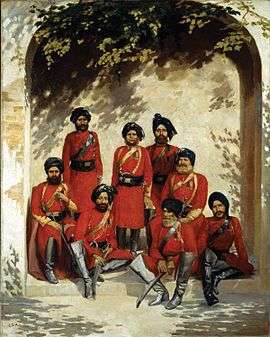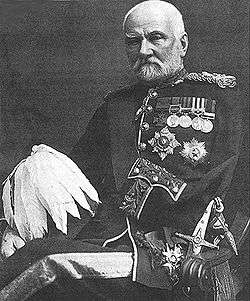12th Cavalry (Frontier Force)
| 12th Cavalry (Frontier Force) | |
|---|---|
_badge.jpg) | |
| Active | 1849 - 1937; 1955 - Present |
| Country |
|
| Branch | Army |
| Type | Armoured Regiment |
| Nickname(s) | Sam Browne's Cavalry |
| Engagements |
North West Frontier of India Indian Mutiny of 1857 Second Afghan War 1878-80 First World War 1914-18 Third Afghan War 1919 Indo-Pakistani War of 1965 Indo-Pakistani War of 1971 |
| Battle honours | Delhi 1857, Lucknow, Charasiah, Kabul 1879, Ahmad Khel, Afghanistan 1878-80, Kut al Amara 1917, Baghdad, Mesopotamia 1916-18, North West Frontier, India 1914-15, East Africa 1917, Afghanistan 1919, Khem Karan 1965.[1] |
| Commanders | |
| Notable commanders |
Sam Browne Dighton Probyn William Vousden Guy Melfort Baldwin |
The 12th Cavalry (Frontier Force) is an armoured regiment of Pakistan Army. It was formed in the British Indian army in 1922 by the amalgamation of 22nd Sam Browne's Cavalry (Frontier Force) and 25th Cavalry (Frontier Force).[2]
22nd Sam Browne's Cavalry (Frontier Force)
The 22nd Sam Browne's Cavalry (Frontier Force) was raised in 1849 at Lahore by Lieutenant Samuel J. Browne as the 2nd Punjab Irregular Cavalry. It was one of five regiments of Punjab Cavalry raised to guard the North West Frontier of India, which soon became famous as part of the legendary Punjab Frontier Force or the "Piffers". Over the next decades, the regiment saw extensive service on the Frontier.[3] During the Indian Mutiny of 1857, the regiment was engaged in the Siege of Delhi, Relief of Lucknow, the Battle of Agra and the Campaign in Rohilkhand. In one of the actions, their commandant, Captain Sam Browne was awarded the Victoria Cross. His citation reads:
- In an engagement with the rebels, Captain Browne, whilst advancing upon the enemy's position, pushed on with one orderly sowar upon a 9-pounder gun and attacked the gunners, preventing them from re-loading and attacking the infantry who were advancing to the attack. In the conflict which ensued, Captain Browne received two sword cuts, one on the left knee and one which severed his left arm at the shoulder, but not before he had cut down one of his assailants. The gun was eventually captured and the gunner killed.
It was the loss of his arm that caused Browne to invent the famous Sam Browne belt, still in the use of many of today's armies. The original belt is on display in the India Room at the Royal Military Academy Sandhurst.
Meanwhile, Captain Dighton Probyn was also awarded the Victoria Cross for gallantry, while serving with the 2nd Punjab Cavalry. His citation reads:
- On many occasions during the period 1857-1858 in India, Captain Probyn performed gallant and daring acts. On one occasion, at the Battle of Agra, when his squadron charged the rebel infantry, he was sometimes separated from his men and surrounded by five or six sepoys. He defended himself and, before his own men had joined him, had cut down two of his assailants.
 Officers of the 2nd Punjab Cavalry, 1880.
Officers of the 2nd Punjab Cavalry, 1880.
During the Second Afghan War of 1878-80, the 2nd Punjab Cavalry was with the Kandahar Field Force, and fought at the Battle of Ahmad Khel in April 1880. During the First World War, the regiment served in the Mesopotamia Campaign.[2][3]
Name changes
- 1849 2nd Punjab Irregular Cavalry
- 1851 2nd Regiment of Cavalry, Punjab Irregular Force
- 1861 2nd Regiment of Punjab Cavalry, Punjab Frontier Force
- 1901 2nd Punjab Cavalry
- 1903 22nd Cavalry (Frontier Force)
- 1904 22nd Sam Browne's Cavalry (Frontier Force)
25th Cavalry (Frontier Force)
The 25th Cavalry (Frontier Force) was raised by Captain Robert Fitzgerald as the 5th Punjab Irregular Cavalry at Multan in 1849. During the Indian Mutiny they were part of the besieging army at Delhi and took part in the Relief of Lucknow. One squadron fought at Bareilly, where two of its Indian officers won the Order of British India and nine other ranks received the Indian Order of Merit. The regiment was involved in a number of small actions on the North West Frontier with the Punjab Frontier Force. In March 1860, 150 men under an Indian officer attacked a 3,000 strong armed force of Mahsuds and Waziris at Tank, killing 300 and dispersing the others. In January 1867, an Indian officer with 27 sowars charged a body of 1,000 tribesmen, killed 150 and captured most of the rest. During the Second Afghan War, the 5th Punjab Cavalry were present at the capture of Charasiah and Frederick Roberts the Commanding General ordered that they and the 9th Lancers should have the honour of escorting him into Kabul. During the attack on the Asmai Heights in December 1879, near Kabul, Captain William John Vousden made repeated charges with a small body of men of the 5th Punjab Cavalry, passing through the ranks of an overwhelming force again and again until the enemy fled. Vousden received a Victoria Cross and his ten surviving men the Indian Order of Merit. During the First World War, it served in German East Africa, followed by service in the Third Afghan War of 1919.[2][3]
Name changes
- 1849 5th Punjab Irregular Cavalry
- 1851 5th Regiment of Cavalry, Punjab Irregular Force
- 1861 5th Regiment of Punjab Cavalry, Punjab Frontier Force
- 1901 5th Punjab Cavalry
- 1903 25th Cavalry (Frontier Force)
12th Cavalry (Frontier Force)
After the First World War, the number of Indian cavalry regiments was reduced from thirty-nine to twenty-one. However, instead of disbanding the surplus units, it was decided to amalgamate them in pairs. This resulted in renumbering and renaming of the entire cavalry line. The 22nd Sam Browne's Cavalry (Frontier Force) and 25th Cavalry (Frontier Force) were amalgamated in 1921 to form 12th Cavalry. The uniform of 12th Cavalry was scarlet with blue facings. The badge showed a mounted figure within a circle carrying the title 'Sam Browne's Cavalry XII FF' with a crown above. Its class composition was one squadron each of Punjabi Muslims, Sikhs and Dogras. In 1937, 12th Cavalry became the training regiment of 2nd Indian Cavalry Group at Ferozepur. It was converted into a training centre in 1940 by amalgamating it with 15th Lancers.[2]
On the partition of India in 1947, this training centre was transferred to Pakistan. On 15 January 1955, 12th Cavalry (Frontier Force) was re-raised at Rawalpindi as a Reconnaissance Regiment of Pakistan Armoured Corps. The regiment has a glorious history during the 1965 and 1971 Indo-Pakistani Wars. During the 1965 War, the regiment fought in four different sectors simultaneously when all four squadrons of the regiment operated independently at Chawinda, Bedian, Khem Karan and Sialkot.[4]

- 1921 22nd/25th Cavalry (amalgamation)
- 1922 12th Cavalry (Frontier Force)
- 1927 Sam Browne's Cavalry (12th Frontier Force)
- 1940 1st Indian Armoured Corps Centre
- 1947 Pakistan Armoured Corps Centre
- 1955 12th Cavalry (Frontier Force) (re-raised)
Affiliations & Alliances
References
- ↑ Rodger, Alexander. (2003). Battle Honours of the British Empire and Commonwealth Land Forces 1662-1991. Ramsbury: The Crowood Press.
- 1 2 3 4 Gaylor, John (1991). Sons of John Company: The Indian and Pakistan Armies 1903–91. Stroud: Spellmount.
- 1 2 3 North, REFG. (1934). The Punjab Frontier Force: A Brief Record of Their Services 1846-1924. DI Khan: Commercial Steam Press
- ↑ The Sabre & Lance: Journal of the Pakistan Armoured Corps. (1997). Nowshera: The School of Armour & Mechanised Warfare.
Further reading
- Regimental Record, 5th Regiment, Punjab Cavalry. (1886). Lahore: W. Ball & Co.
- Regimental Record, 25th Cavalry (FF), 1886-1912. (1912).
- Journal of the late General Sir Sam Browne, VC, GCB, KCSI 1849-98. (1937). Edinburgh: William Blackwood & Sons.
- Gaylor, John. (1991). Sons of John Company: The Indian and Pakistan Armies 1903- 1991. Stroud: Spellmount Publishers Ltd. ISBN 978-0-946771-98-1
- Dey, RSBN. (1905). A Brief Account of the Late Punjab Frontier Force, From its Organization in 1849 to its Re-distribution on 31st March 1903. Calcutta.
- North, REFG. (1934). The Punjab Frontier Force: A Brief Record of Their Services 1846-1924. Dera Ismail Khan: Commercial Steam Press, HQ Waziristan District.
- Hayauddin, Maj Gen M. (1950). One Hundred Glorious Years: A History of the Punjab Frontier Force, 1849-1949. Lahore: Civil and Military Gazette Press.
- Kempton, C. (1996). A Register of Titles of the Units of the H.E.I.C. & Indian Armies 1666-1947. Bristol: British Empire & Commonwealth Museum. ISBN 978-0-9530174-0-9
- Elliott, Maj Gen JG. (1968). The Frontier 1839-1947: The Story of the North-West Frontier of India. London: Cassell.
- Trench, CC. (1988). The Indian Army and the King’s Enemies, 1900-1947. London: Thames and Hudson.
- Lt.Col Muhammad Asaf Hussain Khan was awarded "Sitara e Jurat" Indo-Pak 1965 War at KhemKaram sector for outstanding gallantry
- Captain Ahmed Arsalan Asaf & Captain Nadeem Ahmad Raja are the Siachin Warriors of 12th Cavalary FF.Captain Ahmad Arsalan Asaf participated in Operation Naveed Top .22158 in Balafond Sector in April 1989.
- Capt Mearaj Muhammad of 12th Cavalary FF embraced Martyrdom on 4 June 2009 while fighting with Militants in Buner District. He was Awarded Sitara-e-Basalat by the Government of Pakistan for his Bravery and Sacrifice for his Country.
External links
- Sam Browne's Cavalry (12th Frontier Force) by John Gaylor at The Defence Journal
- 25th Cavalry (Frontier Force) at The British Empire
- Uniforms of the late 19th Century

